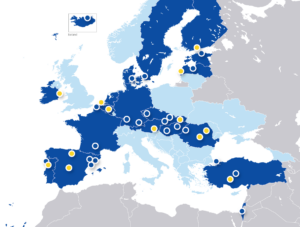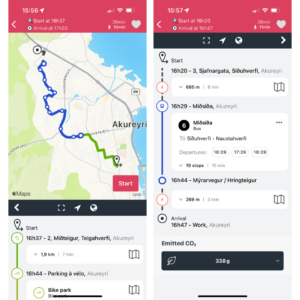Real Solutions for Real Cities
European cities struggle with diverse challenges and barriers to innovative solutions. EIT Urban Mobility’s Rapid Applications for Transport (RAPTOR) programme facilitates connections between public administrations and startups, to pilot agile solutions specifically tailored for each city. The programme has seen a promising impact and continues to pilot projects across Europe.
European cities face diverse challenges. Covering 10.53 million square kilometres, from the Arctic Ocean to the Mediterranean Sea, Europe is rich in geographical and cultural diversity. While this diversity is certainly a strength; it also means that a mobility solution that works well in Iceland will not probably meet the needs of citizens in Greece.
While tailored solutions are necessary, cities have been traditionally tasked with solving their mobility challenges internally, with lengthy bureaucratic processes slowing the pace and breadth of progress. These sometimes opaque procedures are at the detriment of all, as innovative solutions offered by startups and small and medium-sized enterprises (SMEs) have enormous potential to address niche urban mobility challenges.

Map of RAPTOR programme pilots (blue pins: past projects; yellow pins: planned pilots)
Courtesy of EIT Urban Mobility
This facilitation of connections between public authorities and small, private companies is the guiding force behind EIT Urban Mobility’s Rapid Applications for Transport (RAPTOR) programme. The challenge-based programme encourages cities to identify a mobility challenge and invites startups and SMEs to propose promising solutions. Winners are then awarded funding to develop and pilot their solution in (and with) the city over a five-month period.
Adriana Diaz, Interim Director of Innovation at EIT Urban Mobility explains: ‘The RAPTOR programme was founded to help small, innovative companies bypass the traditional hurdles that come hand-in-hand with administrative contracts. By not only providing funding, but also facilitating partnerships and offering guidance, these SMEs and startups can solve well-defined cities’ challenges while also creating references and opportunities for further scaling the adoption of their solution.’
Since the programme’s launch in 2021, 31 pilots have been implemented in 24 cities from 17 countries across Europe. The projects have been varied in scope – focused on addressing the numerous difficulties that cities face in transforming to more sustainable, accessible, and inclusive urban mobility. For example, in 2023 alone, pilots aimed to optimise public transport, micromobility operations, and urban logistics; measure CO2 emissions and bus ridership; and encourage social integration of remote neighbourhoods. The following examples of previous pilots encapsulate the various challenges that RAPTOR programme participants tackle.
Nudg'ing for active mobility

A parent using the Smart Nudges Platform to select sustainable transport options for their child’s school commute.
Image courtesy of Nudgd AB, used with permission
In 2023, Helsingborg, Sweden, received the ‘Cycling Infrastructure Award’ from the European Cyclists’ Federation, but at the time, only 11% of all mobility in the city was occurring via bicycle. Thus, the focus of Helsingborg’s RAPTOR 2023 challenge was a unique one: develop a bicycle culture in the city.
Sweden-based startup Nudgd, and their behavioural-science-fuelled Smart Nudges Mobility platform, utilised ‘nudging’ to motivate users to engage in active mobility. Targeting the commuting habits of elementary students and their guardians and staff, the pilot exceeded Nudgd’s expectations.
Over 2,400 participants from 25 different schools participated; with 39% of participants reporting that they changed, or planned to change, to a more active mode of transport. Additionally, participants were twice as likely than non-users to switch to active transport. Participants received health benefits from choosing active modes for commuting and Nudgd reasoned that the decreased car traffic would increase safety and air quality near the participating schools.
Instant System for increased ridership
In Akureyri, Iceland, riding the bus is free of charge. However, residents perceive the bus as unreliable and infrequent, preferring private vehicles. The city wanted to change these patterns while also encouraging more active mobility. Thus, Akureyri was paired with Instant System, a Mobility-as-a-Service (MaaS) startup.
Instant System’s app-based platform integrates public transport with other mobility options such as cycling, walking, shared mobility, private vehicles for Park & Ride, and on-demand transport for people with disabilities. The app also quantifies each mode’s emissions in comparison to a private car, encouraging modal shifts.
After the initial pilot phase, the Municipality of Akureyri opted to extend for six more months, expanding the solution to the whole city and integrating e-scooter availability. Based on the pilot’s initial success, Instant System predicts a 10% increase in the shift to public transport, micromobility, or active mobility from private car ridership.

Instant System’s MaaS platform, showing the CO2 emissions of each journey.
Reproduced with permission by Instant System.
Getting a consistent Chargeprice
Denmark wants to electrify more than a million vehicles by 2030, and the Capital Region of Denmark offers extensive public and on-street charging infrastructure for electric vehicles (EVs). However, since the price of charging is regulated by the operators themselves, the lack of price transparency can dissuade drivers from making the switch to electric.

Chargeprice’s price transparency solution at work in the Capital Region of Denmark.
Reproduced with permission by Chargeprice.
As a participant of RAPTOR 2023, the Capital Region of Denmark wanted to provide drivers with a transparent overview of charging prices across all EV charging operators. Startup Chargeprice, with their app of the same name, was awarded the opportunity to put their product to the test.
By the project’s completion, Chargeprice had successfully tailored the app to the Danish market and language and removed the necessity for manual price checks, in favour of twice weekly automated updates. As a result, the startup improved data for over 16,600 charging points in Denmark, 900 of which are in Copenhagen.
Throughout the five-month pilot, over 4,200 Danish EV drivers tested the service which allowed them to search based on compatibility, availability, time of day or night, type, and charging speed. This level of customised search allowed for cost savings for drivers of up to 50%, further encouraging the wider adoption of EVs.
RAPTOR in 2024 and beyond
This autumn, the third cohort of the RAPTOR programme will begin their pilots in 13 different cities – from Fingal County in Ireland to Konya, Türkiye, each pilot will tackle a pressing mobility issue. Focused on challenges as wide-ranging as encouraging active mobility for seniors, to optimising urban logistics in low-traffic areas, the programme is anticipated to yield innovative results for years to come.
Click here to read the article in its original format.
About the author:
Bernadette Bergsma, Director of Communications and EU Affairs at EIT Urban Mobility has been involved with the organisation since its establishment. Bergsma has held various roles in marketing, communications and EU relations; and spent 10 years as the City of Eindhoven’s EU Strategic Advisor.
About EIT Urban Mobility:
EIT Urban Mobility is an initiative of the European Institute of Innovation and Technology (EIT), a body of the European Union. Since 2019, EIT Urban Mobility has been facilitating connections between business, academia, research and public organisations; funding innovations and training the next generation of entrepreneurs. Learn more here.
